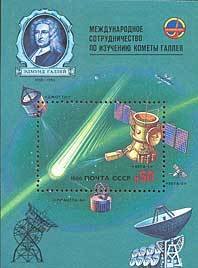Souvenir Sheet: Block: International Programm "Venus - Halley's Comet" (Soviet Union, USSR 1986)
Block: International Programm "Venus - Halley's Comet" (Soviet Union, USSR 1986)
01 January (Soviet Union, USSR ) within release Antarctic Drift of "Mikhail Somov" goes into circulation Souvenir Sheet Block: International Programm "Venus - Halley's Comet" face value 50 Russian kopek
| Souvenir Sheet Block: International Programm "Venus - Halley's Comet" in catalogues | |
|---|---|
| Michel: | Mi:SU BL187 |
Souvenir Sheet is vertical format.
Also in the issue Antarctic Drift of "Mikhail Somov":
- Mini Sheet - 90th Anniversary of First Modern Olympic Games. face value 8*15;
- Souvenir Sheet - Block: International Programm "Venus - Halley's Comet" face value 50;
- Mini Sheet - World Cup Football Championship. face value 40;
- Stamp - Goodwill Games in Moscow. face value 10;
- Mini Sheet - Soviet Autoindustry. face value 8*10;
- Stamp - Olof Palme. face value 10;
- Mini Sheet - E. Korzhenevskaya Peak (7105 m.), Pamir face value 40;
- Mini Sheet - Antarctic Drift of "Mikhail Somov" face value 60;
- Stamp - Steam locomotive FD p 20-578, Kiev face value 30;
- Stamp - Samora Moizes Mashel. face value 5;
- Mini Sheet - Sports Aircraft Designed by Yakovlev. face value 8*5;
- Mini Sheet - Happy New Year. face value 40;
- Stamp - Resolutions of 27th Communist Party Congress. face value 5;
- Mini Sheet - Plants of Russian Steppes. face value 1.60;
- Stamp - Kremlin, Moscow face value 50;
- Stamp - Birth Centenary of Bela Kun. face value 10;
- Mini Sheet - International Programm "Venus - Halley's Cometa" face value 1.20;
- Mini Sheet - Orange Hermit (Satyrus bischoffi) face value 1.60;
- Stamp - Birth Centenary of Ernst Thalmann. face value 10;
- Mini Sheet - "Alley in Albano", by M. I. Lebedev, 1837 face value 8*4;
Souvenir Sheet Block: International Programm "Venus - Halley's Comet" it reflects the thematic directions:
Famous People refers to the fame and public attention accorded by the mass media to individuals or groups or, occasionally, animals, but is usually applied to the persons or groups of people (celebrity couples, families, etc.) themselves who receive such a status of fame and attention. Celebrity status is often associated with wealth (commonly referred to as fame and fortune), while fame often provides opportunities to make money.
A spacecraft is a vehicle that is designed to fly and operate in outer space. Spacecraft are used for a variety of purposes, including communications, Earth observation, meteorology, navigation, space colonization, planetary exploration, and transportation of humans and cargo. All spacecraft except single-stage-to-orbit vehicles cannot get into space on their own, and require a launch vehicle (carrier rocket).
A comet is an icy, small Solar System body that warms and begins to release gases when passing close to the Sun, a process called outgassing. This produces an extended, gravitationally unbound atmosphere or coma surrounding the nucleus, and sometimes a tail of gas and dust gas blown out from the coma. These phenomena are due to the effects of solar radiation and the outstreaming solar wind plasma acting upon the nucleus of the comet. Comet nuclei range from a few hundred meters to tens of kilometers across and are composed of loose collections of ice, dust, and small rocky particles. The coma may be up to 15 times Earth's diameter, while the tail may stretch beyond one astronomical unit. If sufficiently close and bright, a comet may be seen from Earth without the aid of a telescope and can subtend an arc of up to 30° (60 Moons) across the sky. Comets have been observed and recorded since ancient times by many cultures and religions.
Outer space (or simply space) is the expanse that exists beyond Earth's atmosphere and between celestial bodies. It contains ultra-low levels of particle densities, constituting a near-perfect vacuum of predominantly hydrogen and helium plasma, permeated by electromagnetic radiation, cosmic rays, neutrinos, magnetic fields and dust. The baseline temperature of outer space, as set by the background radiation from the Big Bang, is 2.7 kelvins (−270 °C; −455 °F)




